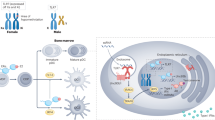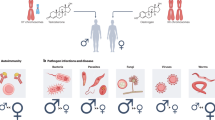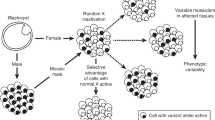Abstract
IN mice and rats there is one exception to the rule that grafts are always accepted between members of an isogenic population. This applies when females are challenged with skin and other tissues from male donors1–6. The ability of females to reject these grafts varies from strain to strain. For example, while virtually 100 per cent of C57BL/6 (hereafter C57) females and about 75 per cent of A strain females reject male skin isografts, CBA and AU strain females usually accept such grafts. This interstrain diversity occurs despite the fact that the specificity of the Y antigen or “Y factor” is apparently the same in male mice of all stocks7. The basis for this variability stems from two factors: the first is the genotype of the female which determines her capacity to react against male skin and the second is the genetic background of the male which influences the expression of the Y antigen8. Thus the complete penetrance of the Y factor in C57 mice is due to the females of this strain being relatively strong reactors against male skin isografts, and is not because the antigen is strongest in this strain. Indeed, that the antigen is weaker in C57 males than in CBA males follows from the fact that (CBA × C57)F1 hybrid females reject grafts from CBA males more frequently than from C57 males8.
This is a preview of subscription content, access via your institution
Access options
Subscribe to this journal
Receive 51 print issues and online access
$199.00 per year
only $3.90 per issue
Buy this article
- Purchase on Springer Link
- Instant access to full article PDF
Prices may be subject to local taxes which are calculated during checkout
Similar content being viewed by others
References
Eichwald, E. J., and Silmser, C. H., Transplant. Bull., 2, 148 (1955).
Eichwald, E. J., Silmser, C. E., and Weissman, I., J. Nat. Cancer Inst., 20, 563 (1958).
Feldman, M., Transplant. Bull., 5, 15 (1958).
Sachs, L., and Heller, E., J. Nat. Cancer Inst., 20, 555 (1958).
Gittes, R. F., and Russell, P. S., J. Nat. Cancer Inst., 26, 283 (1961).
Hoshino, K., and Moore, J. E., Intern. J. Cancer, 3, 374 (1968).
Billingham, R. E., and Silvers, W. K., Ann. Rev. Microbiol., 17, 531 (1963).
Silvers, W. K., and Billingham, R. E., Science, 158, 118 (1967).
VojtÍšková, M., and Poláčková, M., Folia Biol. (Prague), 12, 137 (1966).
Poláčková, M., and VojtÍšková, M., Folia Biol. (Prague), 14, 93 (1968).
Silvers, W. K., J. Exp. Med., 128, 69 (1968).
Billingham, R. E., in Transplantation of Tissues and Cells (edit. by Billingham, R. E., and Silvers, W. K.), 1 (Wistar, Philadelphia, 1961).
Sanford, B. H., Chase, H. B., Carroll, S. B., and Arsenault, C. T., Anat. Rec., 152, 17 (1965).
Engelstein, J. M., Proc. Soc. Exp. Biol. Med., 126, 907 (1967).
Snell, G. D., and Stimpfling, J. H., in Biology of the Laboratory Mouse (edit. by Green, E. L.), 457 (McGraw–Hill, New York, 1966).
Author information
Authors and Affiliations
Rights and permissions
About this article
Cite this article
SILVERS, W., BILLINGHAM, R. & SANFORD, B. The H–Y Transplantation Antigen: A Y-linked or Sex-influenced Factor?. Nature 220, 401–403 (1968). https://doi.org/10.1038/220401a0
Received:
Published:
Issue Date:
DOI: https://doi.org/10.1038/220401a0
This article is cited by
-
Transplantation—caught in the crossfire!
Nature Immunology (2002)
-
Cross-primed CD8+ T cells mediate graft rejection via a distinct effector pathway
Nature Immunology (2002)
-
Sexual differentiation and H-Y antigen
Nature (1982)
-
Assessment of some genetic non-MHC differences with GVHR-induced anti-listeria activity of macrophages
Immunogenetics (1982)
-
Expression of H–Y (male) antigen in phenotypically female Tfm/Y mice
Nature (1975)
Comments
By submitting a comment you agree to abide by our Terms and Community Guidelines. If you find something abusive or that does not comply with our terms or guidelines please flag it as inappropriate.



